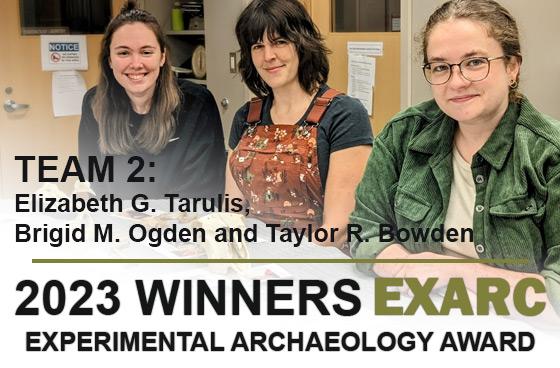
The EXARC Experimental Archaeology Award 2023 opened on May 1st. In the three months we received 22 applications. Thanks to our sponsor, EXARC member John Kiernan, the jury selected two winners of 500 EUR each. Both are teams of three colleagues working together, one from Spain other from US.
Team 2: Elizabeth G. Tarulis, Brigid M. Ogden, Taylor R. Bowden
TITLE: Skin Deep: Determining the Efficacy of ZooMS Methods on Processed Intestinal Artifacts
In the proposed project, our team will recreate a historical condom recipe to analyze the utility of various Zooarchaeology by Mass Spectrometry (ZooMS) methods on processed intestinal artifacts. ZooMS, a peptide mass-fingerprinting technique, uses taxonomic differences in collagen amino acid composition to identify species (e.g. Kirby et al. 2013). We previously performed ZooMS on an intestinal condom to identify its species of manufacture. The Addison Plantation (18PR175) condom was recovered from an 18th-century well feature in Maryland, U.S.A., and curated by the Maryland Archaeological Conservation Laboratory (Garrow and Wheaton, Jr. 1986:214-217). We used three sampling techniques to identify the make-up of the intestinal condom. The “original bag method” is a non-destructive sampling technique that extracts collagen from the interior surface of an archival storage bag (McGrath et al. 2019). The “eraser method” entails gently rubbing an eraser along the artifact’s surface to recover loose collagen peptides through triboelectric charge (Kirby et al. 2013). Finally, we removed a small sample of the artifact for traditional destructive analysis (Ebsen et al. 2019).
Our destructive samples produced conclusive results that the Addison condom was manufactured from a sheep caecum. However, neither the bag method nor the eraser method was effective in this instance. It is possible that non-destructive methods failed because they only analyze the surface of the artifact, which is more susceptible to contamination or degradation. There are a variety of factors that may have influenced collagen preservation, or the object may have come into contact with other sources of collagen during use, deposition, excavation, or curation. Although we cannot assess all factors potentially affecting collagen preservation, we intend to analyze the impacts of the manufacturing process. To do this, we will recreate an intestinal condom from a sheep caecum using a historical recipe (Collier 2007). Before beginning and throughout the manufacturing process, we will sample the caecum using destructive and non-destructive methods. We will then compare the results of all samples to determine which steps of the manufacturing process (chemical and/or physical) could induce contamination or degradation of the artifact’s surface, rendering non-destructive sampling ineffective. We are requesting funding to cover the cost of materials and ZooMS analysis.
While this project specifically looks at intestinal artifacts, the results have implications for the effectiveness of these sampling strategies on other types of processed goods and in other disciplines. For instance, the Anthropodermic Book Project utilized destructive sampling methods, stating that they are unsure whether non-destructive methods would work on tanned artifacts. They intend to test the eraser method on processed books in their future work (Rosenbloom 2020:20). Our project will help researchers determine which ZooMS method is most effective for their purposes and whether destructive analysis is necessary. We will also post updates on the project across social media platforms, creating content about the history and production of condoms geared towards a public audience.
We would like to thank the other applicants for their time to send in their proposals, it was a pleasure to read them, and we hope to hear more about your projects in the future!
